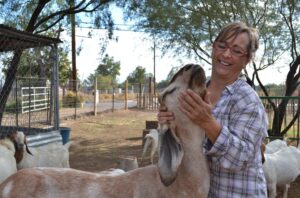A Phoenix farm is making renewable energy while also providing shade for crops

The triple-digit heat in Phoenix makes it difficult to farm — everything from growing crops to tending livestock.
There is a solution that cools off the land while also providing sustainable energy — agrivoltaics. That’s a fancy term that means using large solar panels to provide shade. Of course, such a large undertaking requires a lot of funding that’s hard to come by.
One farm in the Valley adopted agrivoltaics nearly a year ago.
Maya’s Farm is an organic farm run by Maya Dailey. Dailey acquired the farm in 2006 and grew its space from one and one-quarter acres to the eight acres it measures today. The farm focuses on producing crops like carrots and arugula without the use of fertilizers. The farm also has livestock like chickens.
The food that is produced at Maya’s Farm is collected by Community Supported Agriculture, a system that works to combine the produce of a variety of small, local farms to be sold at farmer’s markets.
In 2022, Maya’s Farm became a conservation easement with the support of the City of Phoenix and the nonprofit Central Arizona Land Trust. A conservation easement is a piece of land set aside specifically for one purpose. This land’s purpose is to continue to provide Phoenix with space for sustainable agriculture.
Dailey talked about her commitment to the environment.
“It’s a commodity that we take advantage of it. We use it, use it, use it, use it and abuse it. And then we don’t do anything to give back to that,” said Dailey.
Dailey used diesel-powered generators For 17 years to cover her electric needs. Diesel generators typically can run from eight to 24 hours before needing to be refilled. Maya had to change her generators every six hours.
“I had three of them, and we would just change them in and out. Sometimes we’d leave one on all night. A lot, a lot of, and man hours, too,” she said.
Almost five years ago, the Arizona Sustainability Alliance, known as AZSA, came to Maya with a possible solution to her problem: agrivoltaics.
Agrivoltaics is the use of solar panels in agriculture. Agrivoltaics has been seen to solve both the problem of the lack of space for renewable energy and agriculture by combining them on the same plot of land, typically by installing panels either above or below crops.
Michele Caporali is an external affairs associate with the Nature Conservancy. She was the programs director and education programs manager of AZSA for a year and worked closely on the agrivoltaics project.
“It’s beneficial for the plants. Um, you know, those, you know, those mutualistic relationships that you can get between the plants and the solar panels is great. Um, those plants will cool the solar panels and they’re now able to run more efficiently and they provide some shade when everything around here is cooking at 120 degrees outside,” said Caporali.
The agrivoltaics project at Maya’s Farm went through countless changes throughout its five-year process. The project was funded through grant money and was a partnership with graduate students from the School of Sustainability at Arizona State University. Dailey said that there were many ideas thrown around by the students, but a few years into the project, AZSA and Dailey ran into issues with getting zoning permits from the city of Phoenix and the project stalled.
“The funders were going to pull the resources if we didn’t get the project done at a certain time. And, um, everybody was panicking. I was upset cause we’d worked so hard on it. We didn’t want to lose it,” said Dailey.
The project was finished just over a year ago and has so far benefitted both Maya’s wallet and the farm’s impact on the environment.
“It costs me $25 a month, uh, which is great. As opposed to 700 with the diesel, with the generators. I was running it on generators. So, we lessened our carbon footprint, we decreased our overhead, and we are able to then navigate an educational program with Arizona Sustainability Alliance,” said Dailey.
The limitation of this renewable power project comes down to the resource it depends on, the sun. In locations with frequent cloudy weather, collecting energy from the sun can be difficult. Additionally, some crops like basil or lavender, need direct sunlight to grow.
In urban spaces like Phoenix, it can take quite a while to get an agrivoltaics project started, especially when someone is trying to get a project like Maya’s Farm started through a city government that supports nearly 2 million people.
“If we want to shift … environmental change, agricultural change, the change for our health.” “I mean, we need our communities to pull together and our voices to stand strong together,” Dailey said.
Data about the agrivoltaics project on Maya’s farm is still being collected. Additionally, Dailey has decided to take a season off from growing to focus on getting sustainability into classrooms and to take more time for herself.
